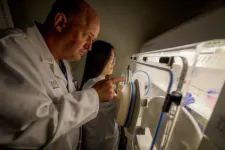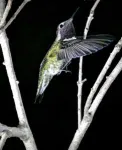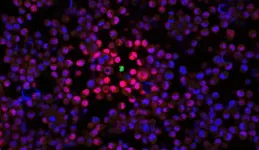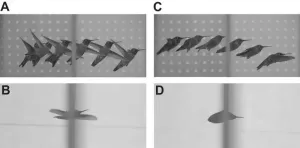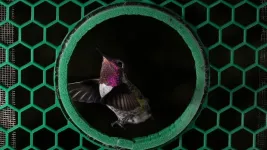(Press-News.org) A four-year, $2.6 million grant to study circadian rhythm and novel therapies to protect the heart during a heart attack or cardiac surgery has been awarded to UTHealth Houston by the National Heart, Lung, and Blood Institute, part of the National Institutes of Health.
Principal investigator Holger Eltzschig, MD, PhD, professor, and co-investigator Wei Ruan, MD, PhD, assistant professor, from the Department of Anesthesiology, Critical Care and Pain Medicine at McGovern Medical School at UTHealth Houston, are studying translational, pharmacologic, and interventional strategies targeting circadian rhythm and hypoxia signaling that could help patients who are experiencing a heart attack or undergoing open-heart surgery.
Previously published research in 2012 and 2021 by Eltzschig and Ruan showed that biological rhythms affect myocardial ischemia and reperfusion injury (IRI) severity. IRI can occur in the setting of a heart attack, open-heart surgery, or during circulatory arrest, where blood flow is temporarily cut off (ischemia). During this period, the affected heart tissues suffer from inadequate oxygen supply (hypoxia). Once the obstruction is removed and blood flow resumes (reperfusion), rather than bringing immediate relief, this sudden influx of blood can lead to additional stress and damage to the heart.
The previous research further indicated that larger infarctions or higher incidences of heart failure happen in patients with morning onset heart attacks rather than later in the day. This daytime variation of myocardial injury hints at a potential interaction between circadian rhythm and hypoxia signaling.
“My laboratory has been very interested in studying IRI for over two decades,” said Eltzschig, the John P. and Kathrine G. McGovern Distinguished University Chair and the director of the Center for Perioperative Medicine at McGovern Medical School. “We undertook an unbiased look to understand the molecular mechanisms of why there are differences in heart attacks in the early morning versus the late afternoon.”
In studies that led up to the current grant application, the team of scientists analyzed heart tissue samples from circadian rhythm-trained mice following heart attacks at different time points of the day. In addition, they analyzed samples derived from the left heart ventricle of patients undergoing cardiac surgery at different times of the day. They identified a highly differentially expressed gene, BMAL1, a core circadian transcription factor. The genetic deletion of BMAL1 in mouse hearts eliminates daytime variations in cardiac injury.
Natural protective molecules called hypoxia-inducible factors (HIFs) are activated due to a lack of oxygen and promote the adaptation to limited oxygen availability. In addition, HIFs limit excessive tissue inflammation in order to prevent further tissue damage. Specifically, researchers uncovered that HIF2A works together with BMAL1 in heart tissues to provide circadian-dependent heart protection.
With this grant, researchers will aim to understand how BMAL1 and HIF2A interact and their functional roles in modulating daytime variation of cardiac injury. High-resolution imaging techniques will be employed to study the molecular interactions between BMAL1 and HIF2A by Kuang-Lei Tsai, PhD, co-principal investigator and assistant professor, and postdoctoral researcher Tao Li, PhD, from the Department of Biochemistry and Molecular Biology at McGovern Medical School. They will further explore the possibility of targeting the BMAL1 and HIF2A pathways as therapeutic strategies to protect the heart from injuries during surgery.
“We are using data to see if the pathways and transcriptional regulations are occurring in patients undergoing cardiac surgery in the morning or the afternoon,” Eltzschig said.
The other co-principal investigator of the study is Jochen Daniel Muehlschlegel, MD, MMSc, MBA, professor and chair of the Department of Anesthesiology and Critical Care Medicine, Johns Hopkins University. NIH Grant R01HL165748 funds this research.
Media Inquiries: 713-500-3030
A four-year, $2.6 million grant to study circadian rhythm and novel therapies to protect the heart during a heart attack or cardiac surgery has been awarded to UTHealth Houston by the National Heart, Lung, and Blood Institute, part of the National Institutes of Health.
Principal investigator Holger Eltzschig, MD, PhD, professor, and co-investigator Wei Ruan, MD, PhD, assistant professor, from the Department of Anesthesiology, Critical Care and Pain Medicine at McGovern Medical School at UTHealth Houston, are studying translational, pharmacologic, and interventional strategies targeting circadian rhythm and hypoxia signaling that could help patients who are experiencing a heart attack or undergoing open-heart surgery.
Previously published research in 2012 and 2021 by Eltzschig and Ruan showed that biological rhythms affect myocardial ischemia and reperfusion injury (IRI) severity. IRI can occur in the setting of a heart attack, open-heart surgery, or during circulatory arrest, where blood flow is temporarily cut off (ischemia). During this period, the affected heart tissues suffer from inadequate oxygen supply (hypoxia). Once the obstruction is removed and blood flow resumes (reperfusion), rather than bringing immediate relief, this sudden influx of blood can lead to additional stress and damage to the heart.
The previous research further indicated that larger infarctions or higher incidences of heart failure happen in patients with morning onset heart attacks rather than later in the day. This daytime variation of myocardial injury hints at a potential interaction between circadian rhythm and hypoxia signaling.
“My laboratory has been very interested in studying IRI for over two decades,” said Eltzschig, the John P. and Kathrine G. McGovern Distinguished University Chair and the director of the Center for Perioperative Medicine at McGovern Medical School. “We undertook an unbiased look to understand the molecular mechanisms of why there are differences in heart attacks in the early morning versus the late afternoon.”
In studies that led up to the current grant application, the team of scientists analyzed heart tissue samples from circadian rhythm-trained mice following heart attacks at different time points of the day. In addition, they analyzed samples derived from the left heart ventricle of patients undergoing cardiac surgery at different times of the day. They identified a highly differentially expressed gene, BMAL1, a core circadian transcription factor. The genetic deletion of BMAL1 in mouse hearts eliminates daytime variations in cardiac injury.
Natural protective molecules called hypoxia-inducible factors (HIFs) are activated due to a lack of oxygen and promote the adaptation to limited oxygen availability. In addition, HIFs limit excessive tissue inflammation in order to prevent further tissue damage. Specifically, researchers uncovered that HIF2A works together with BMAL1 in heart tissues to provide circadian-dependent heart protection.
With this grant, researchers will aim to understand how BMAL1 and HIF2A interact and their functional roles in modulating daytime variation of cardiac injury. High-resolution imaging techniques will be employed to study the molecular interactions between BMAL1 and HIF2A by Kuang-Lei Tsai, PhD, co-principal investigator and assistant professor, and postdoctoral researcher Tao Li, PhD, from the Department of Biochemistry and Molecular Biology at McGovern Medical School. They will further explore the possibility of targeting the BMAL1 and HIF2A pathways as therapeutic strategies to protect the heart from injuries during surgery.
“We are using data to see if the pathways and transcriptional regulations are occurring in patients undergoing cardiac surgery in the morning or the afternoon,” Eltzschig said.
The other co-principal investigator of the study is Jochen Daniel Muehlschlegel, MD, MMSc, MBA, professor and chair of the Department of Anesthesiology and Critical Care Medicine, Johns Hopkins University. NIH Grant R01HL165748 funds this research.
Media Inquiries: 713-500-3030
END
UTHealth Houston researchers awarded $2.6 million NIH grant to study molecular pathways and potential strategies for treatment of myocardial ischemia and reperfusion injury
2023-11-10
ELSE PRESS RELEASES FROM THIS DATE:
What human diseases can teach us about the immune system
2023-11-10
The immune system is a crucial part of our survival, regularly fending off wide-ranging attacks on the body, both internal and external. Unsurprisingly, the elegant defense system that protects us from viruses, bacterial infections, cancer, and other threats is immensely complicated. Each time it mounts a response, it must quickly and carefully orchestrate communication across vast numbers of cells and molecules.
Jennifer Oyler-Yaniv is working to figure out how, exactly, the immune system does this — and when and why it fails.
“There's always the next question, the next ...
Texas A&M researchers contribute to international project studying coronavirus transmission in humans, cattle
2023-11-10
Researchers from the Texas A&M School of Veterinary Medicine and Biomedical Sciences’ (VMBS) Veterinary Education, Research, and Outreach (VERO) program have joined an international team studying how coronaviruses are spread and whether an individual’s microbiome (the collection of microbes living in or on the body) might impact that transmission.
Coronaviruses are a family of viruses that can cause a variety of diseases in many species, from the common cold and severe acute respiratory syndrome (SARS) in people, to diarrhea in calves and respiratory disease in ...
NASA’s Webb, Hubble telescopes combine to create most colorful view of universe
2023-11-10
Astronomers once again have combined the observational powers of NASA’s James Webb Space Telescope and Hubble Space Telescope to create one of the most detailed and colorful portraits of the cosmos, just in time for the holiday season.
The new image, dubbed the Christmas Tree Galaxy Cluster by the research team that includes Texas A&M University astronomer Dr. Lifan Wang, combines visible light from Hubble with infrared light detected by Webb to showcase MACS0416, a galaxy cluster about 4.3 billion light-years from Earth. Because the cluster is able to magnify the light from more distant background galaxies through a phenomenon known as gravitational ...
Ten 2023 postdoctoral fellowships in aging research awarded by the Glenn Foundation for Medical Research and AFAR
2023-11-10
NEW YORK, NY and SANTA BARBARA, CA — The American Federation for Aging Research (AFAR) and the Glenn Foundation for Medical Research are pleased to announce the recipients of the 2023 Glenn Foundation for Medical Research Postdoctoral Fellowships in Aging Research. This program supports postdoctoral fellowswho study basic research mechanisms of aging and/or translational findings that have potential to directly benefit human health.
Selected through a rigorous review process, ten, one-year, $75,000 Postdoctoral ...
Mystery solved: how hummingbirds fly through gaps that are too small
2023-11-10
Soaring, wings outstretched, many birds sail through the air unhindered. However, species that dine on fruit, seeds and nectar must negotiate tiny gaps in cluttered foliage to secure a feast. To pass through apertures, many birds pull in their wings, folding them closer to their bodies. However, some of the most manoeuvrable aviators, hummingbirds, have lost the ability to fold their wings at the wrists and elbows. ‘Unless hummingbirds implement distinctive strategies to transit narrow apertures, they may be unable to enter gaps less than one wingspan wide’, ...
Hummingbirds' unique sideways flutter gets them through small apertures
2023-11-10
Most birds that flit through dense, leafy forests have a strategy for maneuvering through tight windows in the vegetation — they bend their wings at the wrist or elbow and barrel through.
But hummingbirds can't bend their wing bones during flight, so how do they transit the gaps between leaves and tangled branches?
A study published today in the Journal of Experimental Biology shows that hummingbirds have evolved their own unique strategies — two of them, in fact. These strategies have not been reported before, likely because hummers maneuver too ...
National analysis suggests that potentially serious complications occur in 1 in 18 procedures under the care of an anaesthetist
2023-11-10
New survey data from the 7th National Audit Project of the Royal College of Anaesthetists (NAP7) published in Anaesthesia (the journal of the Association of Anaesthetists) shows that potentially serious complications occur in one in 18 procedures under the care of an anaesthetist.
The risk factors associated with these potentially serious complications include very young age (babies); comorbidities; being male; increased frailty; the urgency and extent of surgery; and surgery taking place at night and/or at weekends.
This paper has been produced by a team of authors across ...
Study finds that laser epilation reduces risk of recurrence of pilonidal disease
2023-11-09
Laser epilation, commonly known as laser hair removal, reduced the risk of recurrence in patients with pilonidal disease, an inflammatory, painful, and sometimes chronic or recurring condition, according to research conducted by Peter C. Minneci, M.D., Chair of Surgery at Nemours Children’s Health, Delaware Valley, and published in JAMA Surgery.
Pilonidal disease occurs when cysts form between the buttocks. It is believed to be an inflammatory reaction to hair or debris that gets caught in the crease of the buttocks. The disease occurs in 26 to 100 per 100,000 people and is most common in adolescents and young ...
The U.S. Supreme Court restricted abortion rights and public support for abortion increased
2023-11-09
A new study examining the effects of the U.S. Supreme Court ruling on Dobbs v. Jackson Women's Health Organization on June 24, 2022, which overturned Roe v. Wade's constitutional protection of abortion rights, finds that the American public's support for abortion increased after the decision.
The findings were published today in Nature Behaviour.
"Our results show the extent to which the Supreme Court is out of step with the American public," says co-author Sean Westwood, an associate professor of government at Dartmouth and director of the Polarization Research Lab.
The study's findings were based on a large, three-wave survey before the leak ...
New evidence that heightened pain sensitivity is linked to sympathy for opposing political views
2023-11-09
The next time your friend displays remarkable openness to their opposite political camp’s ideas, you might try pinching them.
Okay, we don’t really recommend that. But new evidence shows that people with increased sensitivity to pain are also more likely to endorse values more common to people of their opposite political persuasion. It doesn’t stop there. They also show stronger support for the other camp’s politicians, and, get this -- more likely to vote for Donald Trump in 2020 if they are liberal, or Joe Biden if they are conservative.
Even ...
